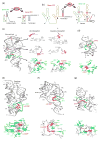Molecular recognition and function of riboswitches
- PMID: 22579413
- PMCID: PMC3744878
- DOI: 10.1016/j.sbi.2012.04.005
Molecular recognition and function of riboswitches
Abstract
Regulatory mRNAs elements termed riboswitches respond to elevated concentrations of cellular metabolites by modulating expression of associated genes. Riboswitches attain their high metabolite selectivity by capitalizing on the intrinsic tertiary structures of their sensor domains. Over the years, riboswitch structure and folding have been amongst the most researched topics in the RNA field. Most recently, novel structures of single-ligand and cooperative double-ligand sensors have broadened our knowledge of architectural and molecular recognition principles exploited by riboswitches. The structural information has been complemented by extensive folding studies, which have provided several important clues on the formation of ligand-competent conformations and mechanisms of ligand discrimination. These studies have greatly improved our understanding of molecular events in riboswitch-mediated gene expression control and provided the molecular basis for intervention into riboswitch-controlled genetic circuits.
Copyright © 2012 Elsevier Ltd. All rights reserved.
Figures




References
-
- Mironov AS, Gusarov I, Rafikov R, Lopez LE, Shatalin K, Kreneva RA, Perumov DA, Nudler E. Sensing small molecules by nascent RNA: a mechanism to control transcription in bacteria. Cell. 2002;111:747–756. - PubMed
-
- Winkler W, Nahvi A, Breaker RR. Thiamine derivatives bind messenger RNAs directly to regulate bacterial gene expression. Nature. 2002;419:952–956. - PubMed
Publication types
MeSH terms
Substances
Grants and funding
LinkOut - more resources
Full Text Sources
Other Literature Sources

